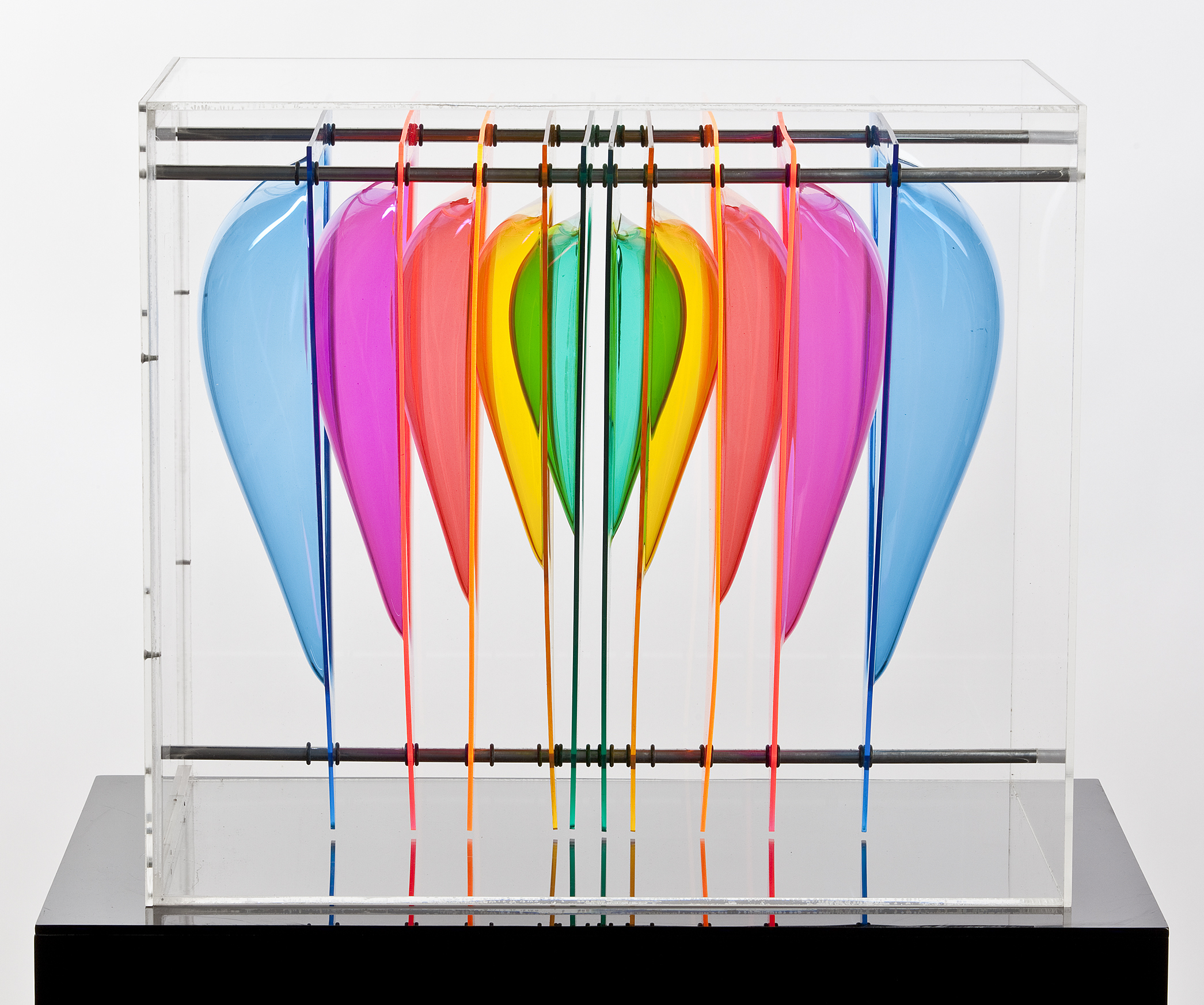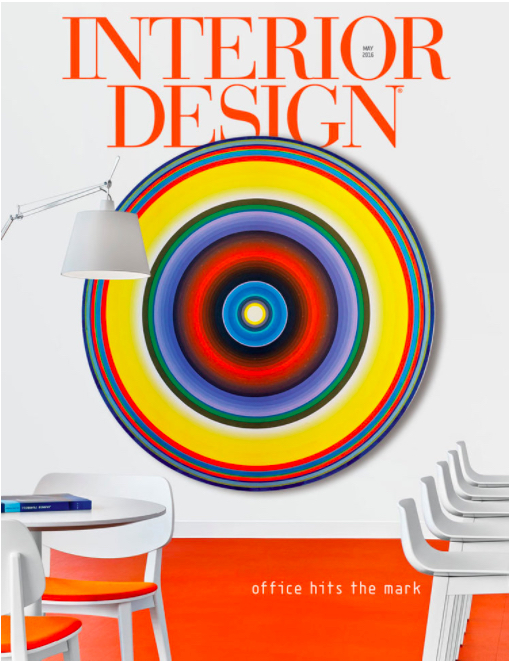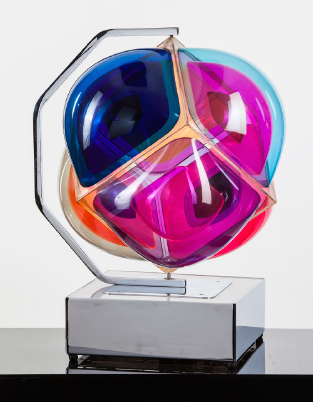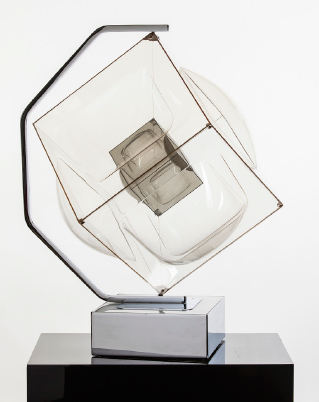AARONEL DEROY GRUBER | Plexiglas Sculptures from the 60's and 70's
May 6 - June 9, 2016
Opening Reception: May 5th, 6-9pm
AARONEL DEROY GRUBER: Plastic Works
-Eric Himmel
Over almost twenty years, from the late 1960s to the mid-1980s, Aaronel deRoy Gruber (1918–2011) created hundreds of acrylic sculptures using techniques that she adapted from industrial processes. Trained as an artist and living in Pittsburgh, where she grew up, Gruber was following a journeyman painter’s well-worn path from Abstract Expressionism through Pop Art to Op Art when a series of encounters diverted her into a more original line of work. Among them, two stand out. Gruber was fortunate to be noticed by the sculptor David Smith, who came to Pittsburgh in 1961 and suggested that she work in three dimensions. According to Gruber, Smith shared with her a beautiful observation about the experience of making sculpture: “One thing suggests another, and you are inspired and learn from one piece to the next. The more you produce, the more experience and emotional evolution is yours.” And after a time when she worked in steel, Smith’s signature metal, Gruber’s New York dealer, Bertha Schaefer, suggested that she try lighter materials. Schaefer, who, as an interior decorator was one of the first to use fluorescent lighting in residential interiors in the 1930s, would have been tuned in to the interest in plastics in the New York art world in the late 1960s.
Artists began to experiment with plastics in the 1930s—László Moholy-Nagy and Naum Gabo were famously pioneers—but it wasn’t until around 1960 that a small movement began to arise. Among plastics, high-quality acrylics, which were marketed under a number of trade names (Plexiglas and Lucite were two of the best known), had became widely available and proved to be an excellent material for sculpture. Acrylic is extremely stable, but can be molded, shaped, and bent with the application of relatively low heat. It’s easily cut, sanded, drilled, and polished, and pieces can be bonded together with virtually invisible, high-strength chemical welds. Among the transparent plastics, it has remarkable crystal clarity, far exceeding that of glass, and it takes color brilliantly and accurately. And it has a diamond’s ability to pipe light: light entering a polished acrylic surface is reflected to edges where the surface is broken, making them glow. Its only flaw as a sculptor’s material is that it’s easily scratched.
When Gruber began to work with acrylics, in 1967 or 1968, the meticulous construction of complex nests of cubes and other rectilinear solids out of clear and colored acrylic sheets was already on its way to becoming something of a cliché—Leroy Lamis had been building them since 1962, and showed them in New York, where Gruber might have seen them, in 1966. Artists and designers working with the medium developed a cult-like perfectionism, since any blemish or imperfection would distract from the Platonic lightness of the resulting object, and this obsession probably inhibited them from manipulating the material more aggressively.
Surveying the field, Gruber too was drawn to the perfect cube made from acrylic sheets or blocks, but she also carried forward from her work as a painter and sculptor in steel a preoccupation with the square with rounded corners. This fascination is said to have been inspired by the shape of contemporary TV screens (although TV screens are not square). What probably began as an artist’s search for a signature shape in a competitive world blossomed, in Gruber’s plastic sculptures, into a deeper exploration of the transformation of a sphere into a cube—a quest that has troubled geometers for centuries—at the same time that Victor Vasarely was using similar motifs in painting.
A question for Gruber was, then, how to incorporate curved surfaces into multi-layered acrylic sculptures? She solved this with vacuum forming, thanks to another encounter: She was renting studio space in a building that housed a business, called Engineered Products, that made plastic skylights with enormous vacuum presses. Vacuum forming is used to create a curved surface in a sheet of plastic. Simply put, a mold is created out of a durable material—plaster or wood will do—and a heated and softened sheet of plastic is sucked over the mold by a vacuum. The most famous, or notorious, use of the technique in the arts was by Lee Bontecou, working around the same time. Allegedly, the critical condescension with which her vacuum-formed plastic flowers and fishes were received when she showed them at the Castelli Gallery in 1970 helped to propel Bontecou out of the New York art scene.
Eventually, Gruber built a workshop with her own vacuum-forming equipment and became skillful at dying and laminating sheets to achieve her own colors, including hard-to-find fluorescents that generated bright edges along seams thanks to the light-piping ability of acrylic. Once she was able to produce precise, and precisely replicable, curved surfaces, Gruber had a toolbox to make sculptures that expressed her vision. In purely formal terms, the work that came out of this toolbox was Constructivist. These were pristine, translucent, symmetrical objects for contemplation, activated by light and the movement of the viewer (and, eventually, in some cases, by electric light and the then-popular low-RPM electric motors that made the sculptures rotate slowly). Their key elements were stacked and boxed-up colored planes, covered with curved surfaces arrested in the process of becoming geometric forms: squares and, later, triangles. This was the main stream of her invention, although she also made complex, polished acrylic solid volumes.
To maintain the illusion that her objects were floating in space, Gruber designed sleek acrylic or chrome pedestals, armatures, and other supports. These are reminders of Gruber’s artistic milieu, which assumed that a small sculpture was destined for a living-room or office shelf—and, indeed, she depended on this market, which was important to her. Today, when similar objects are more likely to be adventurously hung from the ceiling or simply placed on a surface, these elements firmly situate Gruber’s work in the American art world of the late sixties and early seventies, conferring on it a feeling of authenticity of time and place.
And what of the objects themselves? They are deceptively pretty and slightly sterile, as if they were made in a cleanroom rather than an artist’s studio, and in this they speak to serious preoccupations of the 1960s that continue to stimulate our collective dreams. Recently, the Museum of Modern Art unveiled a new installation of its permanent collection from the 1960s. In a departure from the orthodox view of the decade as closing with freshets of minimalism, feminism, and diverse racial perspectives, the last room is devoted to the epochal 1969 journey of Apollo 11, a triumph of the imagination of engineers. At their best, Gruber’s sculptures in their crystalline perfection appear to have arrived at our doorstep from a universe that is remote from human concerns, absorbing light and emitting color to their own mysterious ends. To see one become suddenly illuminated by a ray of sunlight that activates its bright, fluorescent seams, as if it was a device receiving a signal from a distant star, is a somewhat unnerving experience that never fails to deliver a small jolt of pleasure.
In the mid-1980s, Gruber finally came down to Earth. According to her son, Terry, she had become unsettled by her own process, and was in need of a form of expression that yielded more immediate results and was grounded in this world: she chose photography. Furthermore, she was facing practical deterrents to continuing with plastic. Acrylic prices had quadrupled through the years of the Oil Crisis, and it was difficult to keep training new technicians to assist her. When she stopped, she had sketches for more than one hundred new pieces that were not to be. But she could look back on the creation of a large body of work, beautifully and intelligently conceived and using luminous new materials, that have carried the spirit of her time into the present.




